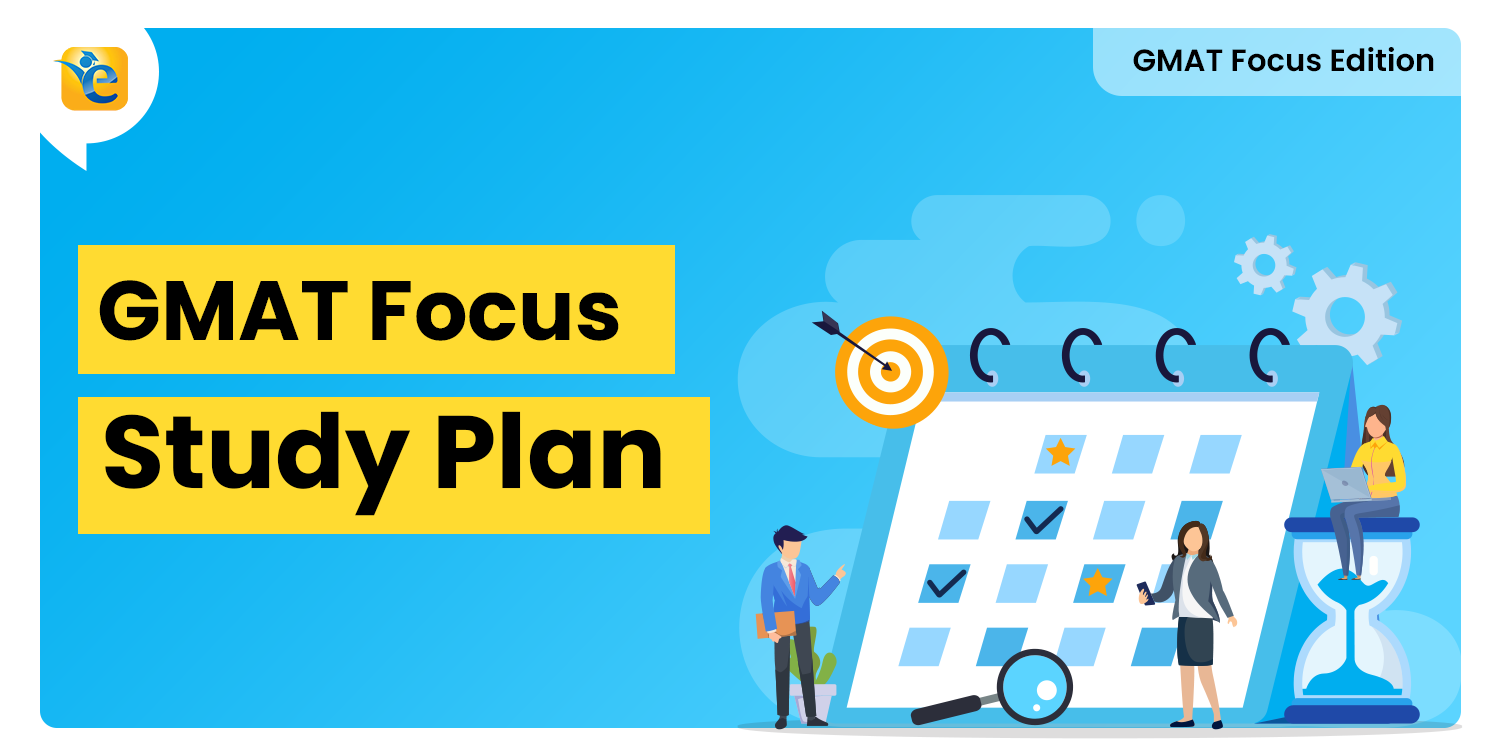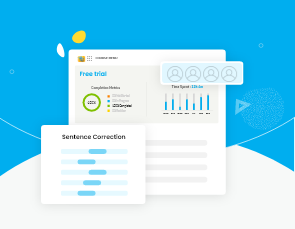You just took a quiz.
The score isn’t where you want to be – you know you can do better. Should you take another quiz right away? That is what a lot of people do.
But wait….
Should you not review this one first?
The answer is yes — you need to review the quiz. But there needs to be a specific framework for it. Just skimming over the incorrect questions is not sufficient.
The truth is most test-takers are reviewing their quizzes wrong. The difference between those who hit their target scores and those who plateau is their review process. The right review process can make or break your GMAT prep. Having worked with hundreds of students toward their success through data-driven plans, I have created a detailed review guide that our students are using to fine-tune and improve their ability.
To help you maximize learning from every quiz, this guide provides a three-level strategic review framework. I’ll share exactly how to conduct this review, including what to look for, which questions need detailed analysis, and how to create an improvement plan from your findings.
Let’s dive in.
Are you planning to pursue MBA at top business schools? Let us help you conquer the first step of the process i.e., taking the GMAT. Take a free mock test to understand your baseline score and start your GMAT prep with our free trial. We are the most reviewed online GMAT Prep company with 2800+ reviews on GMATClub.
The Strategic Review Framework:
Think of quiz review like diagnosing a car’s performance issues. You don’t start by immediately checking individual parts. First, you look at overall performance indicators, then narrow down to specific systems, and finally examine individual components.
A strategic quiz review works the same way, giving you insights at three different levels:
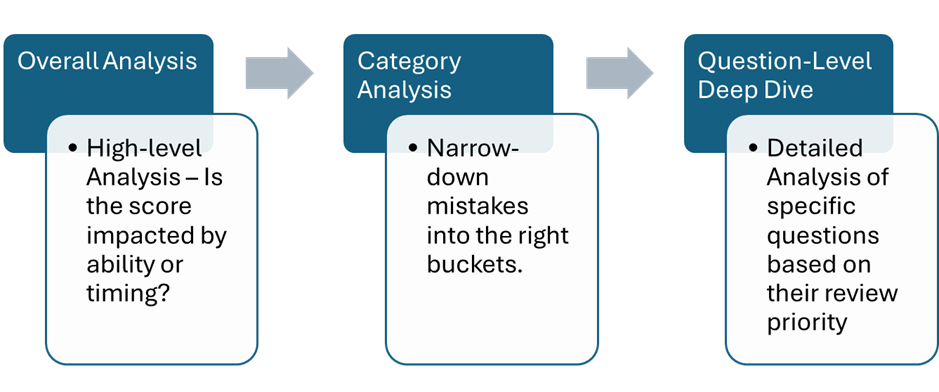
Level 1: Overall Analysis
Before diving into individual questions, step back and look at your quiz from a broader perspective. The first question you need to answer is: What limited your score?
Was it due to limited time or limited ability (or a bit of both)?
Understanding this fundamental aspect determines how you approach the rest of your review. Let’s look at each scenario:
Let’s look at each scenario:
Time-Restricted Score
If you find yourself:
- Running out of time toward the end of the section
- Getting a cluster of questions wrong in the final few minutes
- Having to guess on the last few questions
Then, timing was a key factor limiting your score. Your review needs to focus not just on ability but on time management strategies.
Mistake chart of a timing limited attempt. Note, the series of mistakes towards the end.
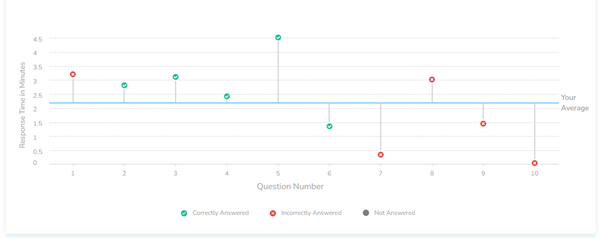
In this image, you can see that:
- there was limited time toward the end.
- most of the mistakes (Q7, Q8, Q9, Q10) were at the end when the time was limited.
So, this is a time-restricted score.
Ability-Restricted Score If you see that:
- You had sufficient time but still got questions wrong
- Your accuracy on certain question types is consistently low
- You’re taking time but making conceptual mistakes Then your core ability needs attention. Your review should focus on understanding concepts and improving your problem-solving approach.
Mistake chart of an ability limited attempt. Note, the mistakes are across the quiz.
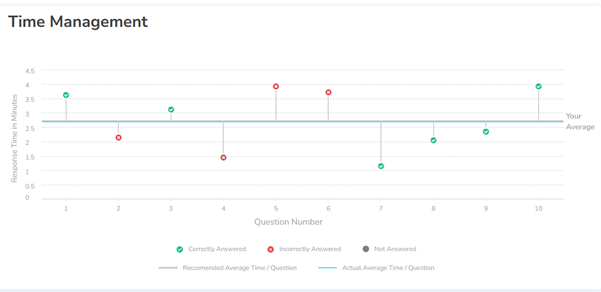
In this image, you can see that
- there was sufficient time toward the end.
- you can see that the student got Q2, 4, 5 and 6 wrong despite having suffcient time at hand.
So, this is an ability-restricted score.
Luck-Influenced Score Sometimes you might:
- Get questions right despite rushing through them
- Arrive at correct answers through incorrect methods
- Have random guesses work in your favor In such cases, don’t let a good score mislead you – these questions need careful review to ensure sustainable performance.
Mistake chart of a luck-influenced attempt. Note, the lucky guess at the end.
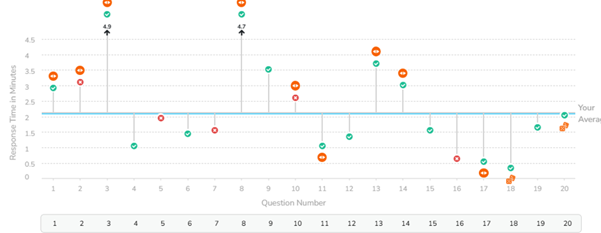
In this image you can see:
- there was limited time toward the end.
- the student got lucky with at least two questions (Q18 and Q20) – did not have sufficient time but still got the question wrong.
So, this is a slightly inflated score.
Level 2: Category Analysis
Once you’ve identified what limited your score, it’s time to look for patterns in your performance. These patterns often reveal improvement opportunities that aren’t visible when looking at individual questions.
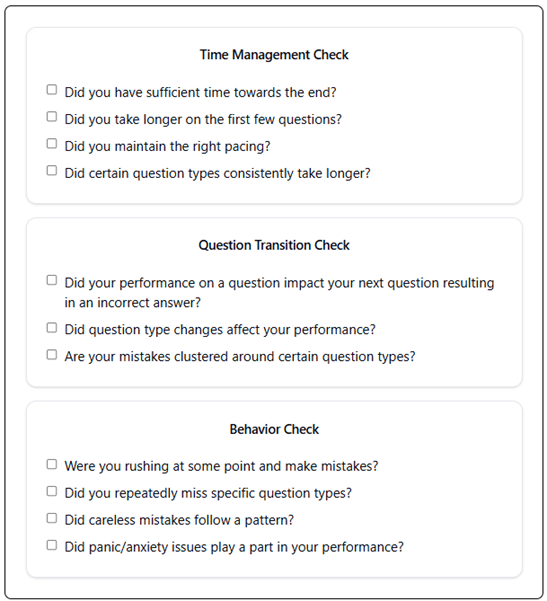
Identifying patterns in your performance is often the key that unlocks consistent improvement. While Level 1 told you what limited your score, pattern analysis reveals how and why these limitations occur.
Think about it: Getting the first RC question wrong on one passage might be one-off, but if you notice that you consistently make mistakes when switching from CR to RC questions or that your accuracy drops in the latter half of sections, you’ve identified a specific area to target in your preparation.
By systematically checking for these patterns, you can make targeted improvements rather than just practicing more questions. Remember, the goal isn’t just to identify what went wrong, but to understand the underlying patterns that need to be addressed for sustained improvement.
Let’s move on to Level 3, where we’ll look at specific question-level analysis.
Are you planning to pursue MBA at top business schools? Let us help you conquer the first step of the process i.e., taking the GMAT. Take a free mock test to understand your baseline score and start your GMAT prep with our free trial. We are the most reviewed online GMAT Prep company with 2800+ reviews on GMATClub.
Level 3: Question Analysis
Now that you understand your overall performance limiters and patterns, it’s time to dive into specific questions. But not all questions need the same level of review – some need deep analysis while others just need quick verification.
Let’s break down your questions into review categories based on both accuracy and time spent:
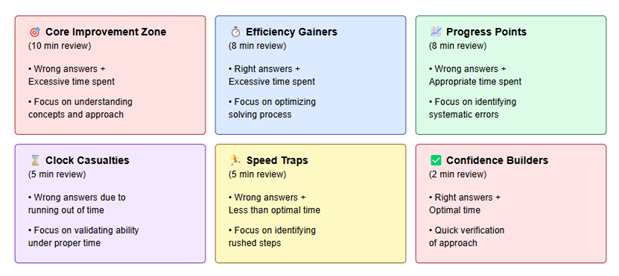
Now that we have our question review framework, let’s see how this works in practice. Here’s an actual quiz performance that showcases each of these categories – helping you understand exactly how to identify and categorize your own questions.
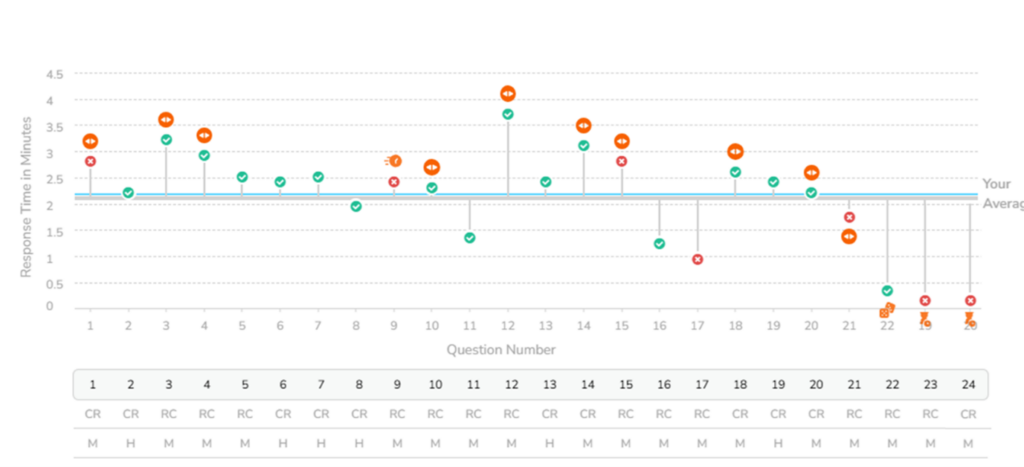
Observe this image carefully – let us categorize the questions into different buckets:
- Core Improvement Zone – Q1, Q15, Q21
- Efficiency Gainers – Q3, Q4, Q10, Q12, Q14, Q18, Q20.
- Progress Points – Q 17
- Clock Casualties – Q22, Q23, Q24
- Speed Traps – Q9
- Confidence Builders – Q5, Q6, Q7, Q8, Q11, Q13, Q16, Q19
Framework for Review
Core Improvement Zone Questions (10 min)
These questions represent your biggest opportunity for score improvement – you spent more time than you should have and still got them wrong. Let’s break down how to review them effectively.
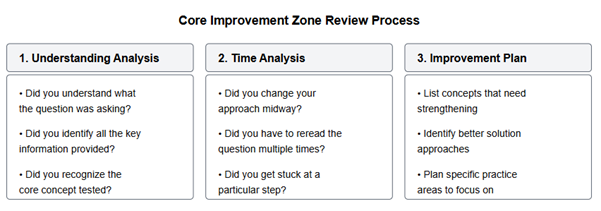
Efficiency Gainers (8 min review):
You got these questions right, but took more time than you should have. While your approach worked, there’s room to optimize your process. Think of these as opportunities to turn good performance into great performance through better time management.
These questions are particularly important because in a test like GMAT, saving time on questions you can solve correctly gives you extra time for tougher questions. Let’s break down how to review these questions systematically.

Progress Points (8 min review)
These are questions you got wrong despite spending the right amount of time on them. You have the time management right, but there’s a gap in your approach or understanding. The good news? These questions often represent your quickest path to improvement because the issue is specific and identifiable.
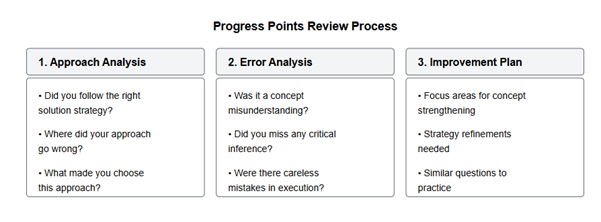
Clock Casualties (5 min review)
These are questions you got wrong because you ran out of time. While it’s tempting to just mark these as “time management issues,” a proper review can reveal if you actually knew how to solve them. This helps distinguish between true ability gaps and mere time pressure mistakes.

Speed Traps (5 min review)
These are questions you got wrong because you rushed through them. Unlike Clock Casualties where you ran out of time, here you deliberately spent less time than needed. These mistakes often reveal gaps in your pacing strategy or show where overconfidence might be hurting your performance.

Confidence Builders (2 min review)
These are questions you got right within optimal time. While it’s tempting to skip reviewing these entirely, a quick verification ensures your success wasn’t just luck and helps reinforce good habits. Remember: consistent good performance comes from understanding what you’re doing right, not just fixing what’s wrong.
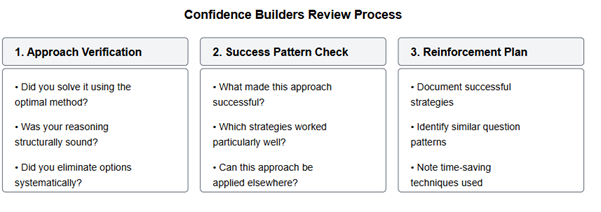
From Framework to Action: Next Steps
Now that you have a structured approach for reviewing each type of question, the key is implementing it effectively. Here’s how to put this framework into action:
- Immediate Implementation
- Start with your most recent quiz
- Categorize questions using this framework
- Apply the appropriate review process for each question
- Document your findings systematically
- Make It a Habit
- Schedule dedicated review time after each quiz
- Use the review time allocations as guidelines
- Focus more time on categories needing deeper analysis
- Build your error log based on these categories
- Track Patterns
- Notice which categories appear most frequently
- Identify trends in your performance
- Adjust your study plan based on these insights
- Monitor your improvement over time
Remember: A quiz is not just a measure of your current ability – it’s a powerful tool for improvement. By using this structured review framework, you transform each quiz from a mere assessment into a stepping stone toward your target score.
The time you invest in proper review pays off multifold in future performance. While it might be tempting to jump to the next quiz, taking the time to understand and learn from each attempt is what separates those who make consistent progress from those who plateau.
Start implementing this framework with your next quiz. Your future self will thank you.
Good luck!
Are you planning to pursue MBA at top business schools? Let us help you conquer the first step of the process i.e., taking the GMAT. Take a free mock test to understand your baseline score and start your GMAT prep with our free trial. We are the most reviewed online GMAT Prep company with 2800+ reviews on GMATClub.


